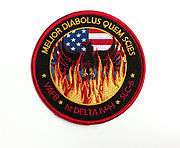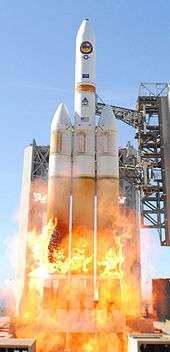USA-224
| Mission type | Optical imaging |
|---|---|
| Operator | US NRO |
| COSPAR ID | 2011-002A |
| SATCAT № | 37348 |
| Spacecraft properties | |
| Spacecraft type | KH-11 |
| Manufacturer | Lockheed Martin |
| Start of mission | |
| Launch date | 20 January 2011, 21:10:30 UTC |
| Rocket | Delta IV Heavy D352 |
| Launch site | Vandenberg SLC-6 |
| Orbital parameters | |
| Reference system | Geocentric |
| Regime | Low Earth |
| Perigee | 270 kilometers (170 mi)[1] |
| Apogee | 986 kilometers (613 mi)[1] |
| Inclination | 97.92 degrees[1] |
| Period | 97.13 minutes[1] |
| Epoch | 5 August 2014, 00:12:52 UTC[1] |
 | |
USA-224, also known as NRO Launch 49 (NRO L-49), is an American reconnaissance satellite which was launched in 2011. It is a KH-11 optical imaging satellite, the fifteenth such spacecraft to be launched, and intended as a replacement of the USA-161 satellite launched in 2001.
Project history and cost

After the failure of the Boeing led Future Imagery Architecture program in 2005, NRO ordered two additional legacy hardware KH-11s. Critics of the decision voiced concerns that each "exquisite-class" satellite would cost more than the latest Nimitz class aircraft carrier (CVN-77)[2] with its projected procurement cost of US$ 6.35 billion as of May 2005.[3] USA-224 - the first of these two - was completed by Lockheed US $ 2 billion under the initial budget estimate, and two years ahead of schedule.[4] USA-224 was launched atop a Delta IV Heavy rocket from Space Launch Complex 6 at the Vandenberg Air Force Base in California. The launch was conducted by United Launch Alliance, and was the first flight of a Delta IV Heavy from Vandenberg.[5] Liftoff occurred on January 20, 2011 at 21:10:30 UTC.[6] Upon reaching orbit, the satellite received the International Designator 2011-002A.[7] The early launch of USA-224, and operational changes to extend the lifetime of its predecessor USA-161, reduced the coverage gap caused by the end of the primary mission of USA-161 to just 33 days.[4]
Of the fifteenth KH-11 satellite to be launched, USA-224 is a member of one of the later block configurations occasionally identified as being a separate system. Details of its mission and orbit are classified, however amateur observers have identified it as being in a Low Earth orbit and tracked it. Shortly after launch it was in an orbit with a perigee of 251 kilometres (156 mi), an apogee of 1,023 kilometres (636 mi) and 97.9 degrees of inclination, typical for an operational KH-11 satellite.[8] By April it was 260 by 987 kilometres (162 by 613 mi) at 97.93 degrees.[9] As of 5 August 2014 it is in a 270 by 986 kilometres (168 by 613 mi) orbit with inclination of 97.92 degrees and an orbital period of 97.13 minutes
See also
References
- 1 2 3 4 5 Peat, Chris (5 August 2014). "USA 224 - Orbit". Heavens-Above. Retrieved 25 January 2015.
- ↑ Iannotta, Ben (2 June 2009). "Spy- sat rescue: Obama's proposal to prevent a gap in coverage sparks debate, optimism". Defense News.
- ↑ O'Rourke, Ronald (25 May 2005). "Navy CVN-21 Aircraft Carrier Program: Background and Issues for Congress". Naval Historical Center.
- 1 2 "10 Who Made a Difference in Space: Bruce Carlson, NRO Director" (PDF). Space News / NRO. 2011-09-07.
- ↑ Ray, Justin (19 January 2011). "Delta 4-Heavy ready to serve nation from West Coast pad". Spaceflight Now. Retrieved 22 January 2011.
- ↑ Ray, Justin. "Mission Status Center". Delta Launch Report. Spaceflight Now.
- ↑ Christy, Robert. "Space events - 2011". Zarya. Retrieved 22 January 2011.
- ↑ Molczan, Ted (21 January 2011). "RE: NROL-49 search elements". SeeSat-L. Retrieved 22 January 2011.
- ↑ Molczan, Ted (2011-04-27). "NROL-34: NOSS 3-5 elements". http://www.satobs.org/seesat. External link in
|publisher=(help)